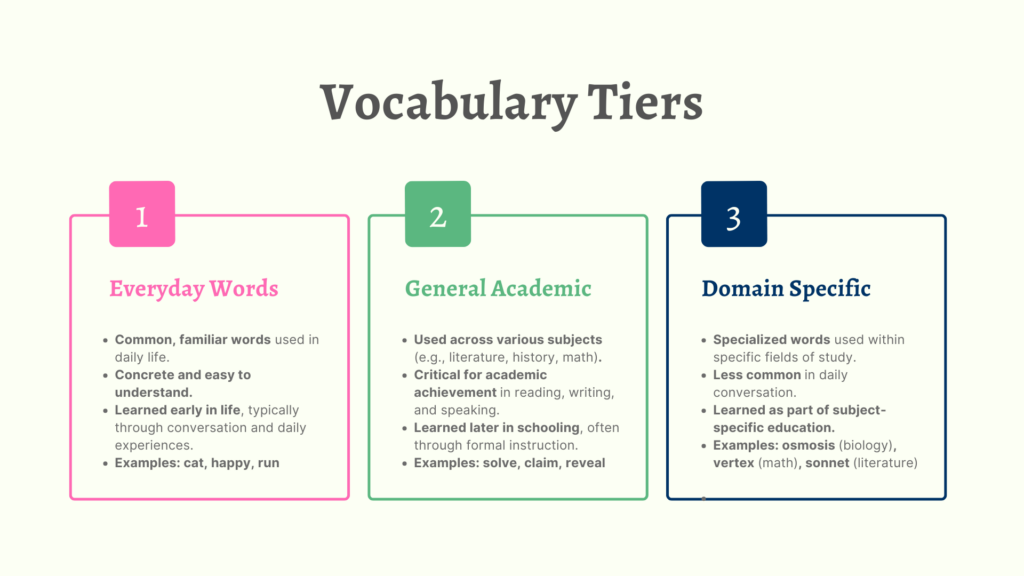Vocabulary Tiers 101

Teaching vocabulary is a daunting, unnerving, intimidating and sometimes taxing responsibility. Understanding and implementing vocabulary tiers can help make this task more manageable and effective. By categorizing words into vocabulary tiers, you can focus your efforts on the most important vocabulary, reducing the overwhelming feeling of trying to teach every. single. word.
Vocabulary acquisition is essential for reading comprehension, writing and overall communication. Never more so than in middle school when the texts are increasingly sophisticated. Students must have the vocabulary and background knowledge to access grade levels texts, decoding simply isn’t going to cut it anymore! Added to that there is an undeniable link between vocabulary and overall academic success. This puts a lot of pressure (weight, burden, stress) on teachers.
But where to start?? Relax. Grab a coffee. Let’s talk about the basics of teaching vocabulary to middle schools.

What are the Vocabulary Tiers?
There are THREE Vocabulary Tiers that middle school teachers work with.
Tier 1: Everyday Words
These are basic, everyday words most students know and use regularly.
Example: cat, run, happy.
Tier 2: Academic and Cross-Curricular Words
These are high-frequency words found in writing and speech, but not as common in daily conversation. They add meaning and nuance. These high-utility words are found in many subjects. Tier 2 vocabulary instruction is critical for reading comprehension once kids hit middle school.
Example: analyze, compare, confident.
Tier 3: Domain Specific
These subject-specific or technical words are used in particular fields of study. While used in relatively low-frequency they are key to academic success.
Example: photosynthesis (science), theorem (math), alliteration (biology).

How to Use Vocabulary Tiers in the Classroom
Still feeling overwhelmed? I know. A lot of students struggle with Tier 2 and Tier 3 vocabulary. The good news? It doesn’t have to be boring or complicated.
As a teacher, you’re juggling a lot, and when it comes to teaching vocabulary, it can feel like there’s just never enough time. But here’s the thing: knowing which words to focus on—and how to teach them—can make a big difference in your students’ learning. Using tiered vocabulary is a smart way to streamline things and help your students build stronger language skills without feeling overwhelmed. Here’s how to fit it into your busy classroom routine.
Tips for Identifying Which Words to Explicitly Teach
1. Prioritize Tier 2 Words
Tier 2 words are the sweet spot. These are the words that pop up across a variety of subjects, so they’re essential for students to understand and use. They’re more complex than Tier 1, but not as specialized as Tier 3. Teaching these words will help your students in almost every subject, so it’s worth the time.
2. Choose Words Students Will See Often
Focus on words that will show up repeatedly. Don’t waste time on one-off words. For instance, words like analyze, significant, or predict are used across literature, science, and history, making them a great choice for deeper understanding and application.
3. Pick Words that Pack a Punch
Look for words that deepen comprehension and help students explain their thoughts. Words like contrast, evaluate, and justify are key to academic success and will help students think more critically.
4. Don’t Forget Subject-Specific Terms
For Tier 3, stick to the core vocabulary for each subject. These words (like photosynthesis in science or equation in math) are essential but can be taught more directly within the context of the subject.

Take care, and happy teaching!
Siân
